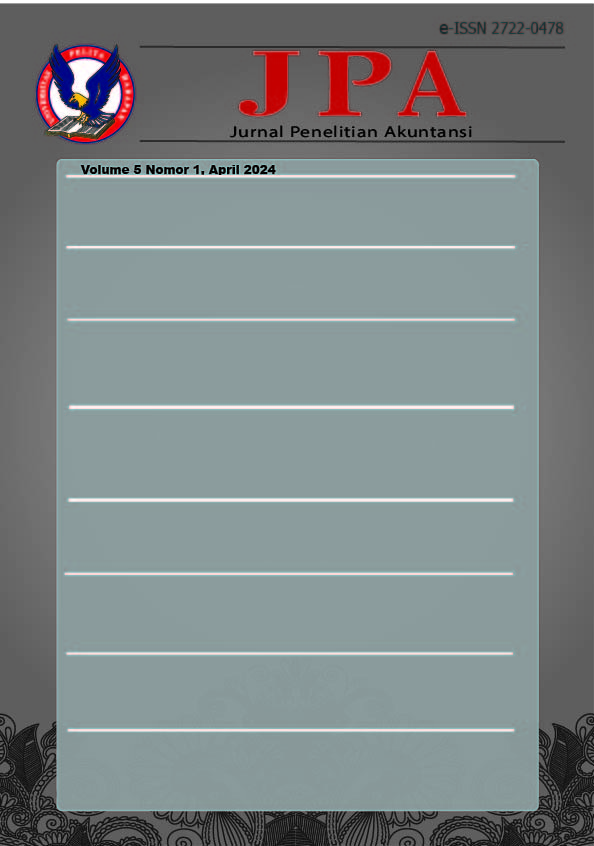The Impact of Profitability, Liquidity, and Company Size toward Tax Avoidance in Consumer Goods Sector Listed on the Indonesia Stock Exchange
Abstract
The objective of this research is to analyze the effect of profitability (measured by return on asset, liquidity (measured by current ratio), and company size (measured by total assets) toward tax avoidance (measured by the effective tax rate) in consumer goods sector listed on the Indonesia Stock Exchange (IDX) for the period of 2019 to 2021.
The population of this research is all consumer goods sector listed on the Indonesia Stock Exchange for the period of 2019 to 2021. By using the purposive sampling method, 32 companies were selected, resulting in a total of 96 samples from three years observation. The data analysis method used descriptive statistics, classical assumption, multiple linear regression, and hypothesis test, which are processed through SPSS 26.
This research finds that profitability, liquidity, and company size do not have significant effect partially on tax avoidance; while simultaneously, the tax avoidance of consumer goods sector listed on IDX from 2019-2021 is not significantly impacted by all independent variables. The adjusted R2 is 1.4%, reflecting the ability of independent variables to make impact to tax avoidance.
Keywords: Profitability, Liquidity, Company Size, Tax Avoidance, Effective Tax Rate
References
Ariyanti, R., Notoatmojo, M., & Kusuma Dewi, O. (2021). Pengaruh Profitabilitas, Liquiditas, Leverage dan Kepemilikan Institusional terhadap Tax Avoidance (Studi pada Perusahaan Manufaktur Sektor Makanan dan Minuman yang Terdaftar di Bursa Efek Indonesia Periode 2015-2019). Jurnal Aktual Akuntansi Keuangan Bisnis Terapan, Vol. 4, No 2.
Aronmwan, E., & Okafor, C. (2019). Corporate Tax Avoidance: Review Of Measures And Prospects. International Journal of Accounting & Finance (IJAF) Vol.8 No.2, 21-42.
Artinasari, N., & Mildawati, T. (2018). Pengaruh Profitabilitas, Leverage, Likuidittas, Capital Intensity dan Inventory Intensity terhadap Tax Avoidance. Jurnal Ilmu dan Riset Akuntansi, 1-18.
Chen, X. (2018). Corporate Social Responsibility Disclosure, Political Connection and Tax Aggressiveness: Evidence from China’s Capital Markets. Open Journal of Business and Management, 151-164.
Dang, C., & Li, F. (2018). Measuring firm size in empirical corporate finance. Journal of Banking & Finance, 159-176.
Darsani, P., & Sukartha, I. (2021). The Effect of Institutional Ownership, Profitability, Leverage and Capital Intensity Ratio on Tax Avoidance. American Journal of Humanities and Social Sciences Research (AJHSSR) Volume-5, Issue-1, 13-22.
Dewinta, I., & Setiawan, P. (2016). Pengaruh Ukuran Perusahaan, Umur Perusahaan, Profitabilitas, Leverage, dan Pertumbuhan Penjualan terhadap Tax Avoidance. E-Jurnal Akuntansi Universitas Udayana, Vol.14. No.3.
Dianawati, dan Agustina, L. (2020). The Effect of Profitability and Leverage on Tax Avoidance with Company Size as a Moderating Variable. Chief Editor, 9(3), 166-172.
Faizah, S., & Adhivinna, V. (2017). Pengaruh Return on Asset, Leverage, Kepemilikan Institusional dan Ukuran Perusahaan terhadap Tax Avoidance. Jurnal Akuntansi Vol. 5 No. 2, 136-145.
Febrilyantri, C. (2022). Pengaruh Likuiditas, Leverage, Ukuran Perusahaan terhadap Tax Avoidance pada Perusahaan Manufaktur Sub-Sektor Otomotif Tahun 2018-2021. Journal of Islamic Banking and Finance, 128-141.
Firmansyah, A., & Triastie, G. (2021). Bagaimana Peran Tata Kelola Perusahaan Dalam Penghindaran Pajak, Pengungkapan Tanggung Jawab Sosial Perusahaan, Pengungkapan Risiko, Efisiensi Investasi? Jawa Barat: Penerbit Adab.
Hery. (2016). Analisis Laporan Keuangan. Jakarta: PT. Grasindo.
Irianto, B., Sudibyo, Y., & Wafirli, A. (2017). The Influence of Profitability, Leverage, Firm Size and Capital Intensity Towards Tax Avoidance. International Journal of Accounting and Taxation Vol. 5, No. 2, 33-41.
Jensen, M., & Meckling, W. (1976). Theory of The Firm: Managerial Behavior, Agency Costs and Ownership Structure. Journal Of Financial Economics 3, 305-360.
Kurnia, Suryani, E., & Suciarti, C. (2020). The Effect of Leverage, Capital Intensity and Deferred Tax Expense on Tax Avoidance. Journal of Accounting Auditing and Business, Vol.3, No.2.
Lessambo, Felix I. 2018. Financial Statement Analysis and Reporting. Springer.
Mardiasmo. (2019). Perpajakan. Yogyakarta: Andi.
Novianti, Andi N., & Sukendar, Heri (2022). Effect of Liquidity, Leverage, Profitability and Company Size on Tax Aggressiveness in Banking Companies Listed in Indonesia Stock Exchange in 2014-2016. 7th North American International Conference on Industrial Engineering and Operations Management,
Noviyani, E., & Muid, D. (2019). Pengaruh Return on Assets, Leverage, Ukuran Perusahaan, Intensitas Aset Tetap dan Kepemilikan Institusional terhadap Penghindaran Pajak. Diponegoro Journal Of Accounting, Halaman 1-11.
Sekaran, U., & Bougie, Roger J. (2016). Research Methods for Business. Wiley.
Sirait, P. (2017). Analisis laporan keuangan. Yogyakarta.
Sugiyono. (2021). Metode Penelitian Kuantitatif, Kualitatif, dan R&D. Yogyakarta: Alfabeta Bandung.
Ulhaq, R., & Effendi, E. (2021). Pengaruh Audit Tenur, Reputasi Auditor, Ukuran Perusahaan dan Komite Audit. Jawa Barat: Penerbit Adab.
Urrahmah, S., & Mukti, A. (2021). The Effect of Liquidity, Capital Intensity, and Inventory Intensity on Tax Avoidance. International Journal of Research - Granthaalayah, 1-16.
Warka, I. W., Sara, I. M., & Ningsih, N. L. (2021). Determinan Profitabilitas Lembaga Perkreditan Desa (LPD). Bali: Scopindo Media Pustaka.
Downloads
Published
Issue
Section
License
Authors who publish with this journal agree to the following terms:
1) Authors retain copyright and grant the journal right of first publication with the work simultaneously licensed under a Creative Commons Attribution License (CC-BY-SA 4.0) that allows others to share the work with an acknowledgement of the work's authorship and initial publication in this journal.
2) Authors are able to enter into separate, additional contractual arrangements for the non-exclusive distribution of the journal's published version of the work (e.g., post it to an institutional repository or publish it in a book), with an acknowledgement of its initial publication in this journal.
3) Authors are permitted and encouraged to post their work online (e.g., in institutional repositories or on their website). The final published PDF should be used and bibliographic details that credit the publication in this journal should be included.


